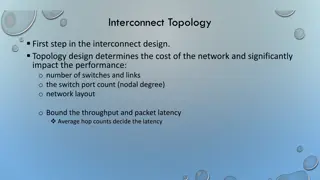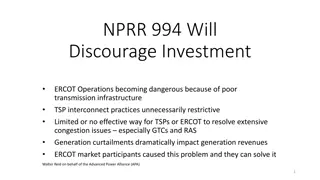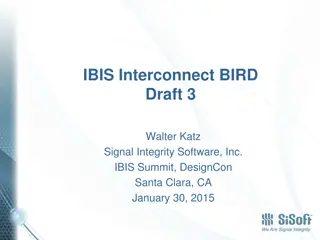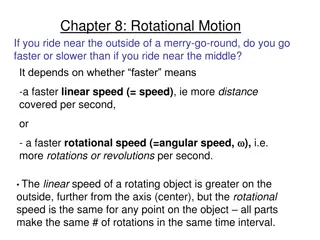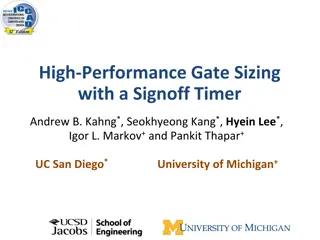The Speed of Diversity: Complex Interconnect Topologies for Global Metal Layer
This paper delves into the intricacies of interconnect topologies in the realm of global metal layer design. Authored by Oleg Petelin and Vaughn Betz for FPL 2016, the content provides valuable insights into optimizing diversity for enhanced performance.
Download Presentation

Please find below an Image/Link to download the presentation.
The content on the website is provided AS IS for your information and personal use only. It may not be sold, licensed, or shared on other websites without obtaining consent from the author.If you encounter any issues during the download, it is possible that the publisher has removed the file from their server.
You are allowed to download the files provided on this website for personal or commercial use, subject to the condition that they are used lawfully. All files are the property of their respective owners.
The content on the website is provided AS IS for your information and personal use only. It may not be sold, licensed, or shared on other websites without obtaining consent from the author.
E N D
Presentation Transcript
The Speed of Diversity: Exploring Complex Interconnect Topologies for the Global Metal Layer Oleg Petelin and Vaughn Betz FPL 2016
Introduction Motivation The Metal Stack Poor wire RC scaling more complex metal stack Lower layers: Many wires, high RC delay Upper layers: Few wires, low RC delay Connecting to upper layers: Deep via stack Intel 14nm Metal Stack 2
Introduction Motivation The Metal Stack 22nm, ITRS 2011 Interconnect Report Metal Layer Pitch RC Speedup 80 Intermediate 48 nm 1x 70 60 Semi-Global 96 nm 7x Per-tile Delay (ps) 50 Global 192 nm 50x 40 30 20 10 0 Global metal layer: small gain for short wires But essential for useful longer wires 3
Introduction Contributions FPGA routing architecture to exploit metal stack Scarce but faster global wires Plentiful but resistive semi-global wires Simultaneously explore: Segment lengths Layer used for each wire type Switch patterns and interconnect hierarchies Requires CAD Enhancements New VPR switch block language arbitrary switch patterns VPR router enhancements optimize for arbitrary interconnect 4
CAD Enhancements Enhanced Switch Block Descriptions Want to turn this into this Multi-Gigabyte Routing Resource Graph Architecture Description File: <switchblock> </switchblock> Concise, human-readable, general description format 6
CAD Enhancements Enhanced Switch Block Descriptions Current limited flexibility: Specify which tracks connect Regardless of wire type and whether wire end or midpoint VPR 7.0 patterns hard-coded: Switch pattern in one keyword, e.g. Wilton, Universal, 0 1 3 2 L3 1 0 1 1 1 0 L2 New more flexible & general Distinguishes between wire types and wire endpoints/midpoints Uses mathematical permutation functions (not keywords) to implement connections 0 0 0 1 2 3 Left Right Left Top Right Bottom L2 midpoints L3 endpoints L3 mid/endpoints all endpoints L2 endpoints L2 endpoints Permutation = t+1 Permutation = t Permutation = W-t 7
CAD Enhancements Enhanced Router Lookahead How to route a connection? BFS Simple, impractically slow Fast routers use a lookahead to estimate remaining cost from intermediate routing points Good lookahead fast, directed routing 8
CAD Enhancements Enhanced Router Lookahead How to estimate remaining cost? VPR 7.0: assume the same wire type can be used to finish the route in an optimal number of segments Efficient, limiting Independence: makes absolutely no assumptions about the FPGA architecture to build large lookup tables of routing costs Very general, very memory-hungry (multiple GBs for 200 x 200 FPGA) Proposed: perform BFS sample routings to build lookup tables of routing costs for each relative coordinate offset Exploit symmetries that exist in island-style FPGAs Fast, memory efficient, handles complex interconnect (10s of MBs for 200 x 200 FPGA) Lookup[wire type A][x-chan][1][3] = 0.6ns Lookup[wire type B][y-chan][5][5] = 1.3ns From wire type | y| | x| From channel 9
CAD Enhancements Enhanced Router Lookahead 10
Complex Interconnect Exploration 11
Complex Interconnect Exploration Methodology 22nm architectures generated with COFFE 85% semi-global layer wires 15% global-layer wires Deep via stack layout difficulties Global wires have connections every 4 tiles Unidirectional Switches semi-global L=4 L=8 global 12
Complex Interconnect Exploration Methodology 9 Largest VTR Benchmarks: Architecture: Benchmark #6-LUTs Parameter PrimaryArch Arch for Verification Logic Block Ten 6-LUTs Eight 4-LUTs mcml 99,700 Logic Block Crossbars Input None LU32PEEng 75,530 Block RAM 32K 18K bgm 30,089 DSP 36x36 36x36 stereovision2 29,849 Channel Width 300 200 LU8PEEng 21,954 Connection Block Flex 0.1 0.2 stereovision0 11,462 Semi-Global Wirelength 4 2 stereovision1 10,366 Global Wirelength 4, 8, 16 4, 8, 16 blob_merge 6,016 Interconnect Hierarchy Discussed Later Discussed Later mkDelayWorker32B 5,580 13
Complex Interconnect Complex Topologies Explored Topology name represents connectivity of wires on global metal layer CB: Connection Block SB: Switch Block 85%, L4 85%, L4 85%, L4 15%, global 15%, global 15%, global (3) On-CB, Off-CB/SB (1) On-CB, Off-CB (2) On-CB, Off-SB 75%, L4 10%, L4* 55%, L4 30%, L4* 15%, global (5) On-CB/SB, Off-CB/SB 15%, global (4) On-SB, Off-SB 14
Routing Example On-CB, Off-CB 85%, L4 15%, global 15
Routing Example On-SB, Off-SB 55%, L4 30%, L4* 15%, global 16
Complex Interconnect VPR 7.0 Default 85%, L4 15%, global VPR 7.0 Default 10 Connects to wire segment start points without distinguishing between wire types 9.5 Only semi-global layer wires ROUTING DELAY (NS) 9 8.5 8 Connects tracks using Wilton permutation function, with unidirectional legalization 7.5 7 0 2 4 6 8 10 12 14 16 18 GLOBAL WIRE SEGMENT LENGTH 17
Complex Interconnect (1) On-CB, Off-CB 85%, L4 15%, global Regular and fast wires form distinct routing networks Used in previous published studies VPR 7.0 Default On-CB, Off-CB 10 9.5 ROUTING DELAY (NS) 9 Worse delay than VPR default (Wilton over all wires) 8.5 8 7.5 7 Deep via stack restrictions global wires too hard to use 0 2 4 6 8 10 12 14 16 18 GLOBAL WIRE SEGMENT LENGTH 18
Complex Interconnect (2) On-CB, Off-SB 85%, L4 15%, global On-CB every output pin is guaranteed a connection to fast routing VPR 7.0 Default On-CB, Off-CB On-CB, Off-SB 10 9.5 ROUTING DELAY (NS) 9 Off-SB increased routing flexibility compensates for decreased flexibility from deep via stacks 8.5 8 7.5 7 Routing delay improved by 5-11% 0 2 4 6 8 10 12 14 16 18 GLOBAL WIRE SEGMENT LENGTH 19
Complex Interconnect (3) On-CB, Off-CB/SB 85%, L4 15%, global Global wires driving switch blocks AND connection blocks adds a small amount of extra routing flexibility VPR 7.0 Default On-CB, Off-CB On-CB, Off-SB On-CB, Off-CB/SB 10 9.5 ROUTING DELAY (NS) 9 8.5 More switches, but not much gain 8 7.5 7 0 2 4 6 8 10 12 14 16 18 GLOBAL WIRE SEGMENT LENGTH 20
Complex Interconnect (4) On-SB, Off-SB 85%, L4 15%, global Connect to global-layer wires exclusively through regular routing wires Improves the delay of long wire segments Driving long global wires from regular routing adds much- needed flexibility VPR 7.0 Default On-CB, Off-CB On-CB, Off-SB On-CB, Off-CB/SB On-SB, Off-SB 10 9.5 ROUTING DELAY (NS) 9 14% delay red. 8.5 8 7.5 Long global-layer wire delay improved by 14% 7 0 2 4 6 8 10 12 14 16 18 GLOBAL WIRE SEGMENT LENGTH 21
Complex Interconnect (5) On-CB/SB, Off-CB/SB 85%, L4 15%, global Little improvement over previous topologies for all global wire segments lengths VPR 7.0 Default On-CB, Off-CB On-CB, Off-SB On-CB, Off-CB/SB On-SB, Off-SB On-CB/SB, Off-CB/SB 10 9.5 ROUTING DELAY (NS) 9 Connection blocks add little routing flexibility to fast wiring given deep via stack restrictions 8.5 8 7.5 7 0 2 4 6 8 10 12 14 16 18 GLOBAL WIRE SEGMENT LENGTH 22
Complex Interconnect Verifying Results with Different Logic Block Architecture 4-LUT logic block without input/output crossbars Trends similar to 6-LUT arch VPR 7.0 Default On-CB, Off-CB On-CB, Off-SB On-CB, Off-CB/SB On-SB, Off-SB On-CB/SB, Off-CB/SB 10 9.5 9 ROUTING DELAY (NS) 8.5 8 But lack of internal crossbars makes switch block connections between semi- global and global wires more important 7.5 7 13% delay red. 6.5 6 5.5 5 0 2 4 6 8 10 12 14 16 18 GLOBAL WIRE SEGMENT LENGTH 23
Complex Interconnect Complex Interconnect Summary Short Global Layer Wires (L=4): Drive from connection block immediate access to fast routing Drive regular (semi-global) wires routing flexibility compensates for deep via stacks semi-global global Long Global Layer Wires (L=16): Drive from regular (semi-global) wires compensate for few start points of long unidirectional wires Drive regular (semi-global) wires semi-global global Shorter global-layer wires (L = 4) perform surprisingly well Shorter wires have better routing flexibility more signals can use fast routing Good routing hierarchies reduce delay by 5-14% vs. VPR default switch and 13% - 15% vs. disjoint global / semi-global networks 24
Conclusions Summary of Contributions General but concise switch block description in VPR And automatic creation of matching routing resource graph General but computationally efficient router lookahead ~10% faster circuits with complex switch patterns Exploration of interconnect hierarchies to take advantage of routing on the global metal layer Good interconnect hierarchy 5-14% faster than VPR s best prior switch pattern 25
Conclusions Future Work Deep via stack layout difficulty restricted global-layer wire connections to one in four tiles Repeat explorations when global-layer via connections are allowed every 2, 8, etc. tiles Considered one global-layer wire type (length) at a time Mixes of wire lengths on the global layer may yield further gains Many new switch fabrics now possible Different patterns, unbalanced multiplexer size/flexibility, 26
Thank You! Oleg Petelin opetelin@eecg.toronto.edu Vaughn Betz vaughn@eecg.toronto.edu 27
Appendix A VPR 7.0 Default On-CB, Off-CB On-CB, Off-SB On-CB, Off-CB/SB On-SB, Off-SB On-CB/SB, Off-CB/SB Complex interconnect topology per-tile areas 6-LUT logic block 16000 15800 PER-TILE ROUTING AREA 15600 15400 15200 15000 14800 0 2 4 6 8 10 12 14 16 18 GLOBAL WIRE SEGMENT LENGTH 28








